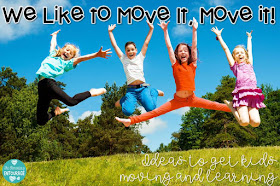The topic of physical movement embedded in instructional settings is HUGE! The research is strong and it expands in a variety of ways. As adults, we all know we don't learn when we are sitting in lectures. So why in the world would we ever assume a young human could?!?!
Currently as a 5th Grade ELA teacher in tight quarters with 50+ large bodies, I was in search of some moving / life skills to implement in my classroom. Today, I'm going to share with you how I keep the students moving in our classroom.
Going into my journey I was looking for a way to allow my students to move their bodies in a healthy manner that included strategies of concentration, focus, decompressing and alignment.
I found myself reading and researching online for solutions that would work in my classroom. I immediately started looking for more information on blood flow, oxygen flow, calorie burning, posture, body alignment, focus and concentration.
I began with a complete flexible seating classroom. The research of alternate seating all leads to increasing consistent positive body movements which then leads to inner body functions flowing constantly which allows alertness.
I wrote a complete blog post of how I created a budget friendly classroom transformation on my blog and the reasons why flexible seating improves inner health through the positions of your body.
[click here or on any of the photos below for a direct link]
Then I began breathing and meditation exercises combined with yoga for our transitions between Reading and Writing.
My classroom's daily agenda:
1) Daily Language/Grammar and Focus Board
2) Writing Block
3) Break- Breathing, Meditation, Yoga
4) Reading Block
The research of breathing, meditation and yoga in schools is completely spot on in my classroom.
The yoga exercises allowed my students not only to move their bodies through stretches and poses, but it also helps align the child's spine. This is a huge benefit to me as a child's spine needs to be stretched into the proper position every so often after sitting in a position for a certain period of time. Yoga poses allow for proper blood and oxygen flow through your body as the poses change in a sequence. Yoga also helps to build core strength and muscle strength in the limbs.
The breathing and meditation exercises allow my students to center themselves as the day progresses. It's very important to me to teach my students life strategies that they can use beyond my classroom. This is a single time each day where my students are able to close their eyes and focus only on there own mental state. I have students with high anxiety and really bad nerves. Students need a strategy that allows them to step back, refocus and then return to a task. It helps students to be able to focus on their breath as a strategy and as an anchor to their inner-self.
Here are some cards I use daily in my classroom. They allow teachers to read to the students as the meditation, breathing or yoga activity goes on. I simply play music through Pandora or Spotify.
Click
here to purchase these cards for your classroom or on the photo below -
Here as a small clip from my classroom, I sped the timing in it up a little bit...
Everything in the video comes from teaching students from these cards!
I hope this informational has helped you in a useful manner! There are a ton of different routes to go when implementing movements into your classroom! I hope you follow me along my journey by click below:-)



















































